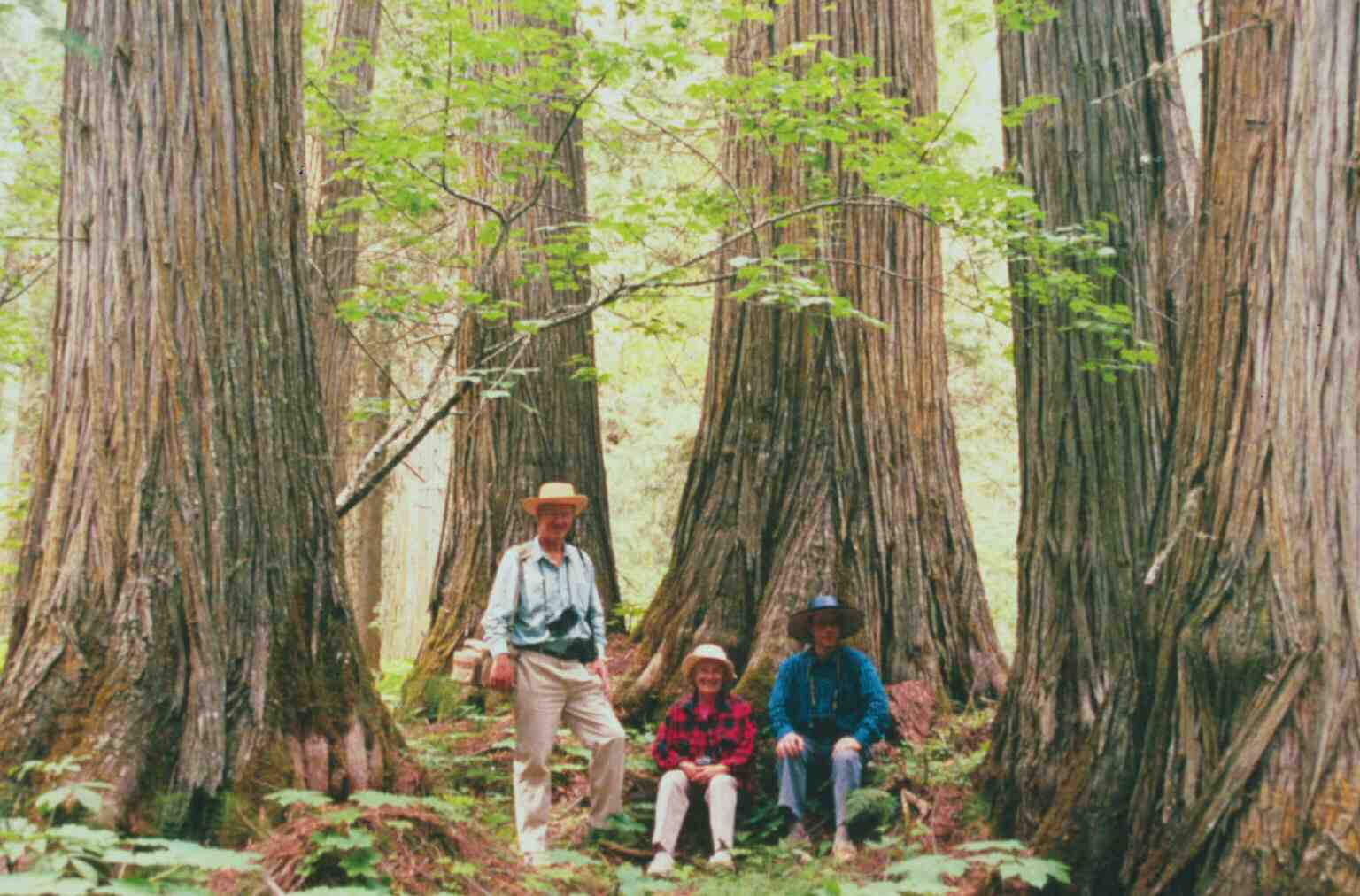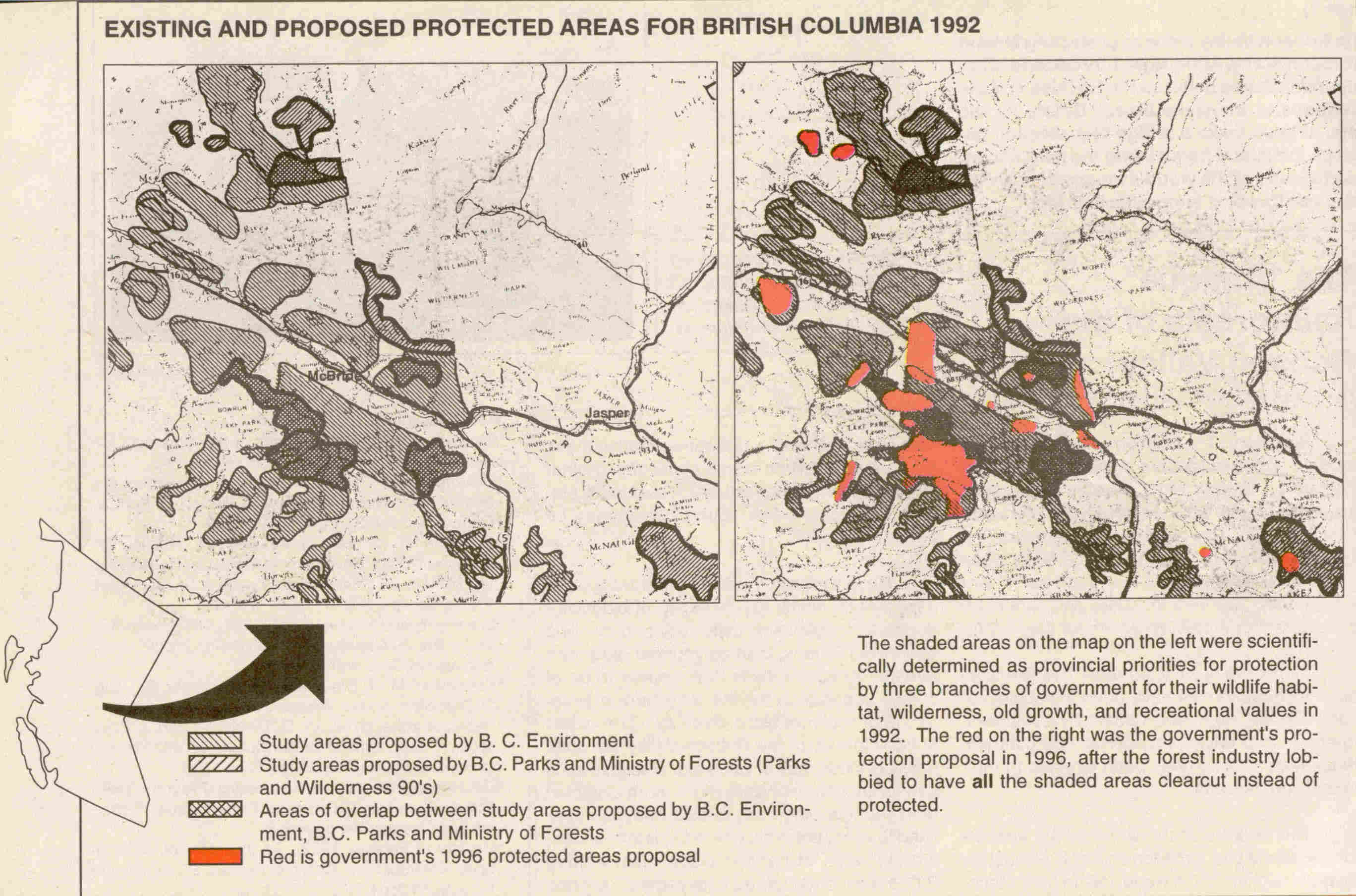
BRIDGE THE ISLAND PARKS WITH ANCIENT RAINFOREST BIODIVERSITY
Save-The-Cedar League Educational Report No. 1, 1996
New research in the Rocky Mountain Trench between the Rocky and the Cariboo Mountains of East-Central British Columbia, Canada has revealed that the old-growth forests of the Robson Valley contain the world's most extensive example of an interior (oroboreal) rainforest(a) at temperate latitudes. The most ancient parts of this 500,000 hectare (2,000 sq mi) rainforest are made-up of old old-growth termed "Antique Forest"(b). This "Antique Forest" may represent "one of the longest unbroken biological traditions of any forested inland region" at temperate latitudes--an "exceptionally rich assemblage" of "distinctly oceanic ecologies" near the Continental Divide deep inland--a Continental Rainforest(a). Ancient Red Cedars, many over 800 years-old and 2.5 meters in diameter, are found among at least 30 lichen species dependent on old-growth rainforests. These and other lichens are a source of nourishment for some of the most unique and diverse food-webs in North America.

A NEW UNDERSTANDING OF OLD-GROWTHNESS
It has recently been discovered that there is a gradual increase in diversity of some plant groups as a forest ages. The number of lichen species increases the longer a forest remains in a state of old growth. The more species of lichens there are the more rare lichens are found. The term "Antique Forest" is now used to distinguish between forests that are only as old as their oldest trees and those forests that have remained as old growth for two or more generations of trees(b). Individual trees age and die but the ecological continuity of the forest remains. Just as many diverse human life spans create human culture over many years, many tree life spans create an Antique Forest over many centuries.
The Antique Forests of Robson Valley are unique in the world and their discovery has caused excitement in the international scientific community. This phenomenon is usually restricted to small watersheds on the windward slopes of the Columbia and Rocky Mountains. The Robson Valley is the only area in which extensive tracts of the Continental Rainforest occupy a major river valley (Fraser River).
ECOSYSTEM FOR KEY WILDLIFE SPECIES AT RISK OF DISAPPEARING
This ancient rainforest and the mountains surrounding it contain over 240 bird and 60 mammal species. Twenty of the mammals are larger carnivores, ungulates, or "key umbrella indicator species" of Conservation Biology: grizzly bear, black bear, wolverine, fisher, otter, marten, cougar, lynx, bobcat, wolf, coyote, red fox, woodland caribou, mountain goat, elk, bighorn sheep, moose, mule deer, white-tailed deer, and beaver. Some of the large, rare, sensitive, or endangered birds which live in the Robson Valley are peregrine & prairie falcons, bald & golden eagles, sandhill crane, great blue heron, trumpeter & tundra swans & long-billed curlew(c). Concisely, one-fourth of the mammal or bird species at risk of disappearing from British Columbia are found in this ancient rainforest and its surrounding mountains (species Blue or Red Listed by government that are described as sensitive/vulnerable or threatened/endangered). There are so many "key" species that the Robson Valley must be considered as a "key ecosystem" to protect.
ENDANGERED HABITATS OF HIGH PRODUCTIVITY & DIVERSITY
This unique rainforest also contains 9 of the 11 wildlife "habitats of major concern" determined by governments to be at risk of disappearing from British Columbia, including internationally significant old-growth forests, wilderness areas, and winter range habitats. Moreover, the second most biologically productive (biomass per hectare) old growth forests in Canada(d,e) and the highest diversity of native tree species found in any single forest of British Columbia(e) are all found in this same rainforest in the Robson Valley (includes 12 conifers).
HEADWATERS OF GLOBALLY SIGNIFICANT WATERSHEDS ENDANGERED
All of these unique values are nestled among some of the best Montane wilderness (one is 6000 sq km), wildlife observation areas, recreation values, aesthetics, and water-quality in Canada. The headwaters of 10 major rivers are attached to the Robson Valley: Fraser, Columbia, Peace, Thompson, Quesnel, Kakwa, McGregor, Morkill (contains the caribou calving grounds for Willmore Wilderness Park in Alberta), Raush, and Cariboo Rivers. The first four of these rivers are globally significant. The Fraser River has the 2nd greatest mean annual flow in Canada and is the dominant river of British Columbia with 25% of the Province's watershed. The Fraser begins its 1375 km (855 mile) journey to the Pacific Ocean from its source in the shadows of Mount Robson, the highest peak in the Canadian Rockies. The Fraser is also the world's most productive, free-flowing, salmon-bearing river. There are hundreds of salmon-spawning grounds with thousands of salmon and many fish species in the headwaters of the Fraser & Columbia Rivers(f). The Thompson River world-renowned for trout and salmon begins in the Cariboo Mountains adjacent to the Robson Valley. Half of the undeveloped, unprotected watersheds left in Southern British Columbia that are over 400 sq km in area are connected to the Robson Valley (upper Morkill, Raush, Herrick, Hugh Allan, Walker, and Goat watersheds)(g).
FOREST INDUSTRY TO DESTROY RAINFOREST, BIODIVERSITY & ECONOMICS
The ancient "Antique Rainforest" of the Robson Valley is of international significance(a). However, with current logging plans 95% of it is to be destroyed by the forest industry(h). The surrounding Rocky and Cariboo Mountain Parks contain only island fragments of this magnificent forest. These unique habitats are being clearcut by more than 200 truck loads everyday during the winter logging season. Some of the clearcuts planned in the next five years are more than 100ha and several clearcuts are being linked to create the equivalent of new openings of more than 1000ha. Plans are now being made to create a huge clearcut similar in size to the infamous Bowron Clearcut--the largest clearcut in the world. Socio-economic and environmental reports predict collapse of economics and biodiversity in Robson Valley because the sustainable, nature-based economies of the Valley will be destroyed by clearcut logging(i). Additionally, the annual cut has recently been re-established at a rate that is unsustainable. The government and industry have promoted logging over preservation in the name of economics, even though logging generates only $1-2 from each 50 cents spent for "development", whereas parks generate $4-5 from each 50 cents spent for park "development"(j,k). Parkland-use supplies a higher return on investment every year than logging supplies once every 100 years. Notwithstanding, the top-ranking sites originally proposed by government have been dropped from the list of proposed protected areas. The large undeveloped watersheds, internationally significant old growth forests, scenic ridges of high biodiversity, critical wildlife habitat, and Antique rainforests found nowhere else have been deleted from the new protected area lists and some are being clearcut right now.

CHANGE THE TIDE OF EXTINCTION
Dr. Paul Paquet's recent Rocky and Cariboo Mountain research article explains: "the long-term prospects for large carnivores are poor...healthy populations are not ensured by existing protected areas in the Rocky (and Cariboo) Mountains...habitat corridors that link isolated core habitat areas are desperately needed..."(l). Other research recommends: "any attempt to maintain old growth values on the basis of one or a few setasides is doomed from the outset...there must be a fully replicated system of protected areas spanning the length of the (Robson) valley..."(a). Government has ignored these articles and the consensus Old Growth Strategy (1992) that maps Old Growth Planning Cells of Robson Valley(m).
You can change the tide of extinction by helping us preserve critical connecting corridors between the Rockies, Cariboos, Monashees, Willmore Wilderness, Kakwa, Monkman, Wells Gray, Bowron, Mount Robson, Jasper, Hamber, and Banff Parks. Too few people live in the Robson Valley to mount a broad campaign for protection by ourselves. The Forest Practices Code and the government's stated goal of 12% of the land in protected areas is not enough to protect biodiversity. Protected dispersal corridors of complete ecosystems that connect protected habitats are necessary for survival of all animals, plants, and lichens of the Rocky and Cariboo Mountains region. Protecting critical carnivore habitat in the Robson Valley leads to protecting almost all biodiversity, Antique Rainforest, and other natural features between the Rockies and the Cariboos at the same time. Before its too late, help us make a bridge of protection between the island parks using the magnificent biodiversity of the world's most extensive inland rainforest at temperate latitudes(a).
HOW YOU CAN HELP
1) Join Save-The-Cedar League ($15/yr), make a tax-deductible, charitable donation of $30, $50, $100, $250, or any other amount (charitable organization registration number 89089 2490 RR0001), and ecotour the Robson Valley rainforest with us (8995 Loos Road, Crescent Spur, BC, VOJ 3EO, Tel/Fax: (250) 553-2325, Email: STcedarL@aol.com).
2) Call or write to connect to local MLA's, Minister of Forests, Minister of Environment, Lands & Parks, and the Premier at the Parliament Buildings, Victoria, BC, V8V 1X0. Tell them you want the biodiversity and ancient rainforests of the Robson Valley protected from logging. Ask them not to sell out to the forest industry the socio-economics, old growth, Antique rainforests, and sustainability of the Robson Valley for the present and future generations.
3) Elect politicians to your local, regional, provincial, state, and federal governments who support protecting Robson Valley.
4) Fight for Ancient Forest Protection and Endangered Species legislation.
LITERATURE CITED
(a)Goward, T. 1995. Macrolichens of the oldgrowth forests of the Robson Valley. MOF Report, 19 p.
(b)Goward. T. 1994. Notes on oldgrowth-dependent epiphytic macrolichens in inland British Columbia, Canada. Acta Bot. Fenn. 150:31-38.
(c)Zammuto, R. and R. Howard. 1994. Wildlife Enhancement Plan Development Project for Robson Valley. Ministry of Environment, Lands & Parks Report, Prince George, B.C.
(d)Bradley, T. 1991. Old growth forests-literature review and initial methodology. Silva Ecosystem Consultants Report.
(e)Ketcheson, M., T. Braumandl, D. Meidinger, D. Demarchi,and B. Wikeem. 1991. Interior Cedar-Hemlock zone, p 168, In, D. Meidinger and J. Pojar (eds.). Ecosystems of British Columbia. BC Ministry of Forests Special Report No. 6.
(f)Fish Habitat Inventory and Information Program. 1990. Stream Summary Catalogues. Department of Fisheries and Oceans, Vancouver, B.C.
(g)Ministry of Forests. 1992. An inventory of undeveloped watersheds in British Columbia. BC Ministry of Forests, Victoria, B.C.
(h)Ministry of Forests. 1995. Robson Valley and Prince George Timber Supply Areas: Timber Supply Review Discussion Papers. BC Ministry of Forests, Victoria, B.C.
(i)Ministry of Employment and Investment. 1995. Robson Valley LRMP: Summary of socio-economic and environmental base cases. BC Ministry of Employment and Investment Report, Victoria, B.C.
(j)Horne, G. and C. Powell. 1995. British Columbia Local Area Economic Dependencies and Impact Ratios. Ministry of Finance and Corporate Relations, Victoria, B.C.
(k)Coopers & Lybrand Consulting. 1995. Economic Benefits of British Columbia Parks. BC Ministry of Environment, Lands and Parks Report, Victoria, B.C.
(l)Paquet, P. and A. Hackman. 1995. Large carnivore conservation in the Rocky Mountains: A long-term strategy for maintaining free-ranging and self-sustaining populations of carnivores. World Wildlife Fund Canada, Toronto, Ont. 52 p.
(m)British Columbia Ministry of Forests. 1992. An old growth conservation strategy for the Robson Valley Forest District. 47 p.